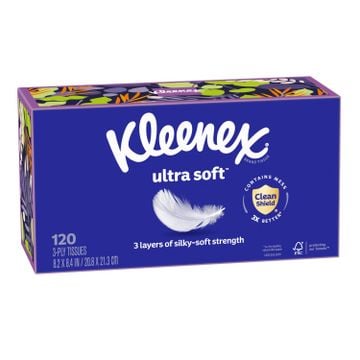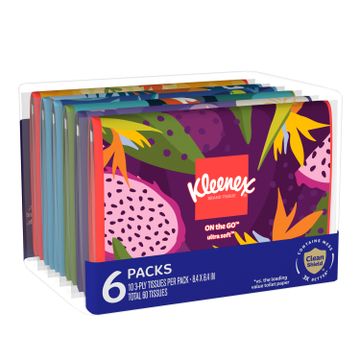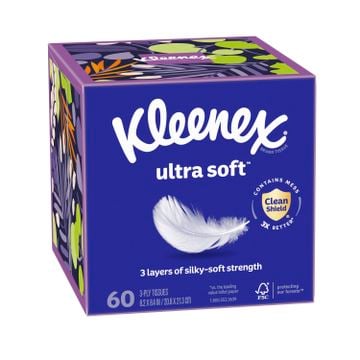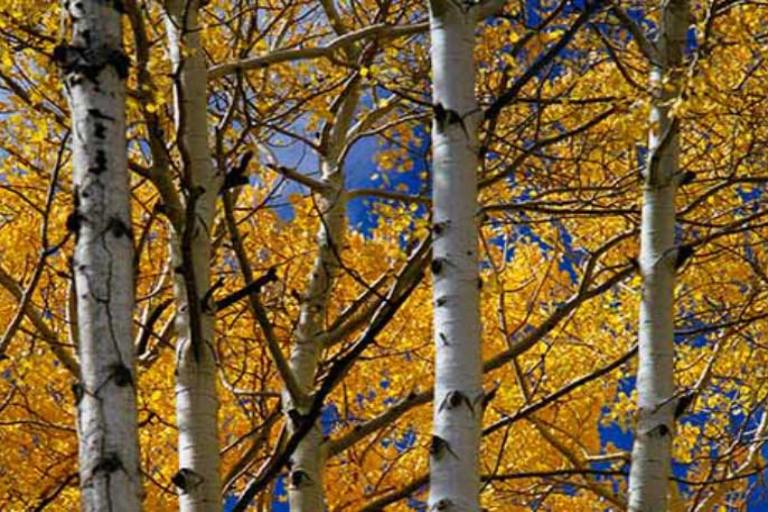
A Seasonal Guide to Pollen by Month
Maybe you’ve heard people say there are only two seasons: winter and construction? The same holds true for pollen counts, unfortunately for those who experience allergies and hay fever. Canadian pollen counts tend to be low to nil over the coldest months and on the rise otherwise. There’s still hope though! While hay fever peaks last up to seven months, the good news is most people won’t be dealing with allergies for that length of time. Different months bring with them different pollens - and these each come with their own symptoms. All you need to do is take note when your nose starts twitching, your eyes watering and you’re reaching for the Kleenex® facial tissues. Check out our calendar below and see if you can identify the pollen that’s causing the problems.
Tree pollen is the first to arrive in the pollen calendar in February, followed by grass pollen taking over in June and July, and finally weed pollen showing up in August. In this guide, we’ve taken a closer look at the different pollens that come out to play month-to-month.
Pollen Types by Month
Learn when the different types of pollen come out, and don’t forget you can use our Pollen Pal to check for low pollen areas near you.
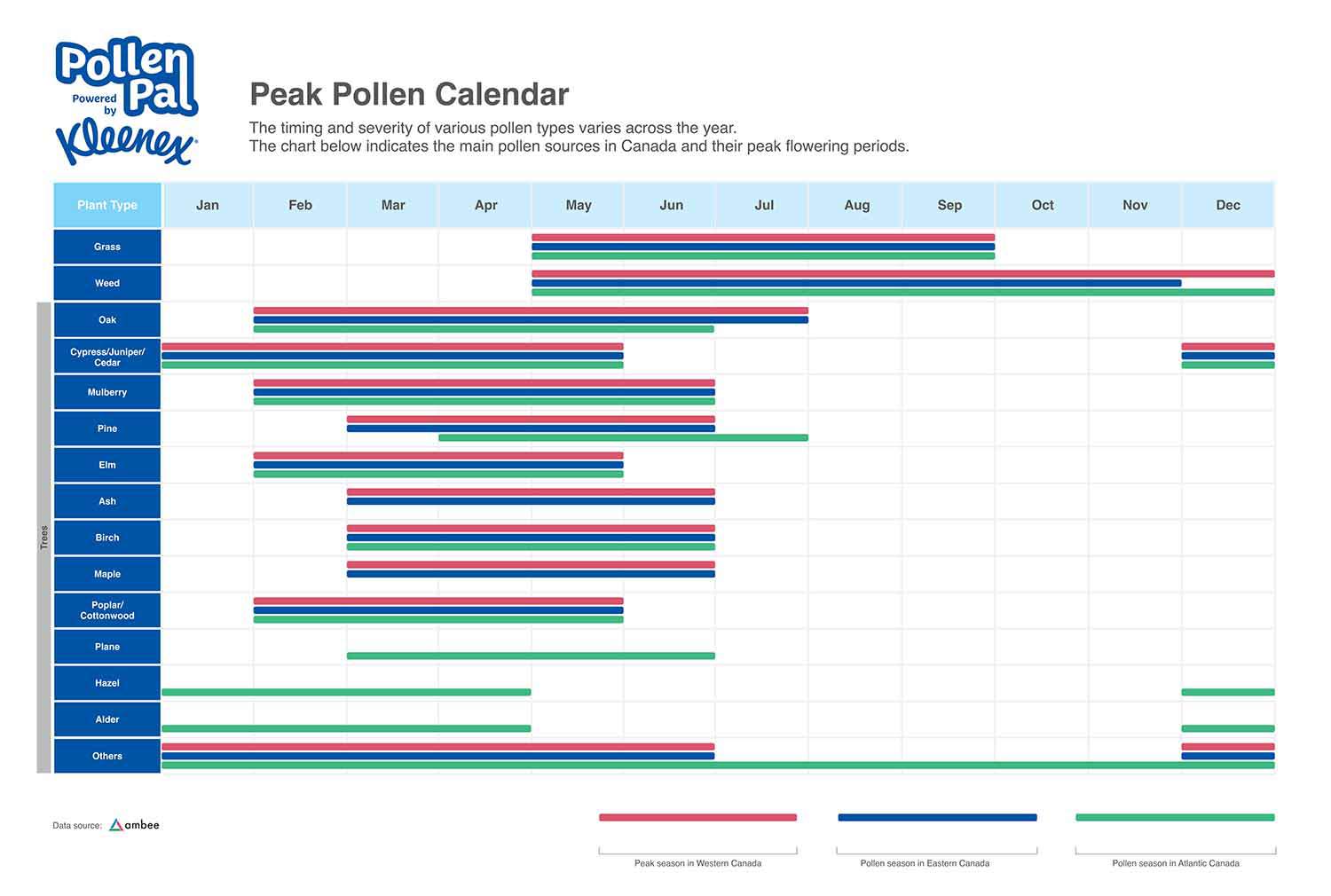
- January
- February
- March
- April
- May
- June
- July
- August
- September
- October
- November
- December
With snow covering most of Canada, this month has a low pollen count. Certain types of tree pollen are beginning to wake up in British Columbia – specifically cedar. Having trouble distinguishing between hay fever and a winter cold? Check out our guide to find out the differences.
British Columbia in particular will begin to feel the effects of tree pollen season as oak, elm, maple and mulberry pollen are added to the mix.
Seasonal allergy sufferers in Quebec, Ontario, Manitoba, Saskatchewan, and Alberta can now empathize with their fellows in BC. In March, ash, poplar, and plane pollen make an appearance. Hay fever in March rises due to elm, mulberry and maple pollen, which are beginning to reach their peak production.
By April no one is exempt: trees are producing pollen right across the country.
April may be known for its showers, but it’s also the beginning of the end for tree pollen season. However, the rise of Kentucky grass signals the upcoming grass pollen season.
By May, pine pollen reaches its peak, accompanied by sycamore trees. Kentucky, Bermuda, Johnson, orchard, and Timothy grasses are spreading their pollen evenly across Canada.
By June, pines, birch and oaks are the primary producers of tree pollen. Sweet vernal joins the party and adds its pollen to the other grasses.
In July, Atlantic Canada will see a reprieve from tree pollen. Grass pollen is peaking in every province, and ragweed begins to appear in Quebec and Manitoba.
The good news is that tree pollen production has peaked with the exception of a few late bloomers, and for British Columbia that means allergy season is coming to a close. For the rest of the country, ragweed is now the dominant pollen producer, along with dock, nettle, mugwort and plantain.
Ragweed is on the decline, signaling that hay fever season is finally winding down. Feel free to take a deep breath without causing any runny noses or itchy eyes – and hope that the sun sticks around to make the most of it!
With autumn in full swing, enjoy the relief of allergy season! Throughout this season weed pollen, although minimal, is most prevalent.
November’s pollen count tends to be low, along with the temperature across the country as we see the first frost. Weed pollen remains prevalent across the country.
December brings the first official day of winter in Canada which means traditionally low levels of pollen for the next few months. Across the country, trees will slowly begin producing pollen again.
When are Types of Pollen most Common?
While there are many different hay fever causes, they all fall under one of three main categories: tree, grass and weeds. While there’s some crossover of the three variants, they each have their own specific hay fever season in Canada.
- Tree pollen season
- Grass pollen season
- Weed pollen season
is the first to arrive in February and tree pollen counts remain high until July when pine pollen season ends.
begins in April and remains active until the end of summer.
begins in July, becomes dominant in August and tapers off in September.
Pollen Type by Season
- Spring (March, April and May)
- Summer (June, July, August)
- Autumn (September, October, November)
- Winter (December, January, February)
Tree pollen (starting in March) and grass pollen (in April) are present all spring. Tree pollen and grass pollen have peaked, so spring hay fever symptoms could be more severe, such as painful sinuses and a cough.
Summer hay fever brings with it a peak in grass and weed pollen, meaning itchy and watery eyes could be much worse, especially when enjoying outdoor activities or cutting the grass.
Hay fever in autumn reduces as pollen production dwindles in September and October.
Tree pollen can begin its season as early as January, but more often in February, and starts earliest in B.C. This means hay fever in winter can sometimes be mistaken for a cold as symptoms include a runny or blocked nose, sore throat, cough and itchy eyes.
If you’re planning on making the most out of pollen season this year, prepare for the great outdoors by reading our tips to help manage your symptoms!
